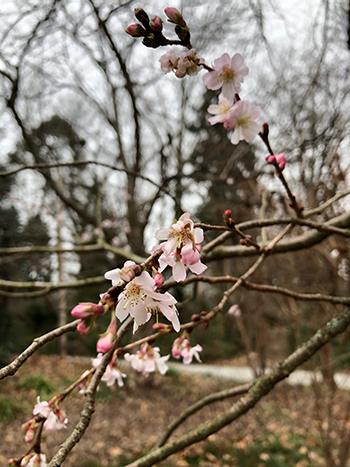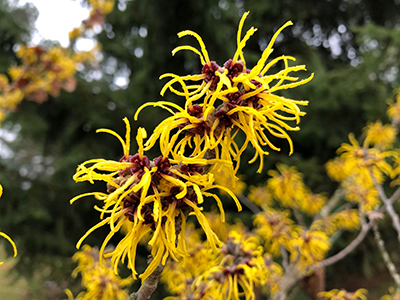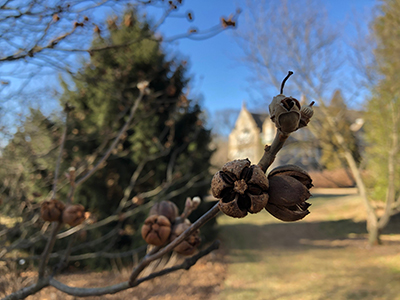
The white to pale pink flowers of Prunus subhirtella open intermittently from autumn through spring. The Higan cherry is a naturally occurring hybrid. Likely a cross between P. incisa and P. spachiana, several forms and cultivars are known, including ‘Jugatsu-zakura’. This selection is unique for its tendency to bloom during mild weather in the winter. While open flowers are susceptible to frost, not every bud opens simultaneously. This protracted bloom period increases the likelihood that some flowers will open and bloom unscathed. ‘Jugatsu-zakura’ is planted on the left hand side of the Cherry Border when looking toward the Cunningham House. Photo credit: J. Coceano

Hamamelis x intermedia ‘Winter Beauty’ is covered in golden yellow blooms with a subtle yet striking fragrance. This particular cultivar, located in the Pinetum, matures to 10’ in height with a slightly smaller spread. Hamamelis x intermedia are fantastic deciduous shrubs for adding winter and early spring color to the garden. With so many cultivars available, it can be a challenge to select one or two to add to your personal garden. Visit the Scott Arboretum over the next several weeks to see dozens of Hamamelis bloom. With witchhazels scattered throughout the arboretum, consider using Arboretum Navigator to locate each variety. Photo credit: J. Coceano

A happy, thriving Franklinia alatamaha in full flower is a sight to behold. The lustrous dark green leaves giving way to shades of orange and red in autumn are equally striking. The combination of flower and foliage, coupled with the tragic story of its disappearance from the wild, make it a plant most gardeners yearn to grow. While its beauty is undeniable during the growing season, I find myself fascinated with the curves and lines of the stems, buds, and woody fruit in winter. Dirr, in his technical yet romantic prose, describes the buds as elongated and silky with scales weakly overlapping. The woody, 5-valved capsule is ½” to ¾” in diameter; “a rather curious fruit on close inspection and one which is not easily forgotten.” Fruits split into ten segments, each with several angular seeds within. Mature specimens of Franklinia alatamaha can be seen in the Tree Peony Collection and at the Northern section of the Cherry Border. Photo credit: J. Coceano
